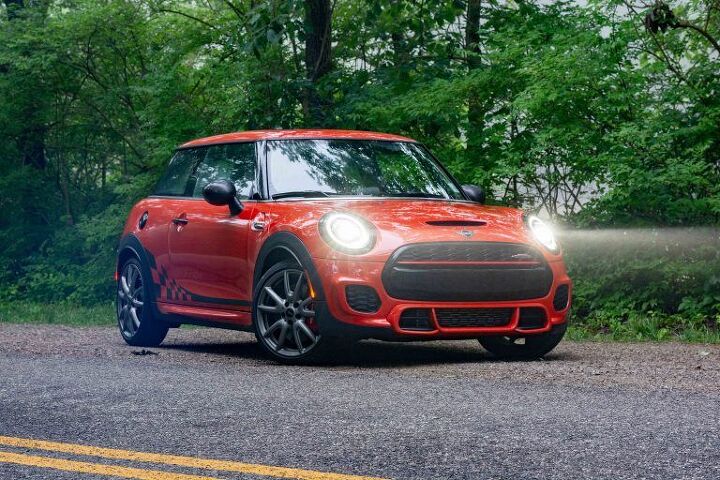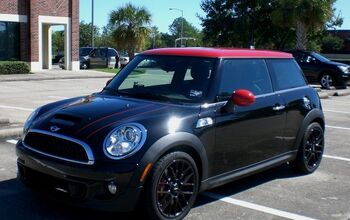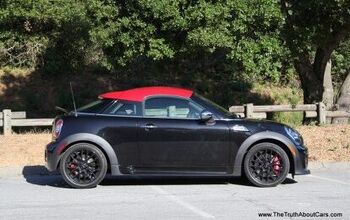2019 Mini John Cooper Works Review - A Proud Heritage

2019 Mini John Cooper Works Hardtop
Does retro work when the retro becomes just plain old? The late Nineties and early Aughts saw an explosion of cars designed to ape cars of yesteryear – possibly to comfort a car-buying public terrified of what a new millennium might bring. The PT Cruiser, the HHR, and the New Beetle were among many models intentionally built to look backwards.
Mini, on the other hand, was an entire marque created out of nostalgia, and for two decades has traded on a wistful look back at the pioneer of the small front-drive econobox with an ever-growing portfolio of “same sausage, different lengths” models. Today, we look at the 2019 Mini John Cooper Works Hardtop – the original flavor three-door hot hatch. Does it still evoke the spirit of the Sixties, or is it a thoroughly modern conveyance in hand-me-down clothes?
The styling is unmistakably Mini, with short overhangs, a big frowning mouth, and a pair of roundish headlamps dominating the front just like every Mini since the Fifties. The lower facia is a bit busy compared to the first generation of the BMW-built Mini Cooper from 2000, however, with more ducts and bulges distracting the eye.
Out back, the dual central exhaust tips remain as a signature of the hottest hatch. The Union Jack reflected in the taillamps is a bit cheesy, but still a fun reminder of heritage. I could do without the black plastic cladding lining the lower surface of the entire car, however, as it’s a design crutch that tends to signify “SUV” these days.
The interior is a bit goofy looking in places, with a great deal of hard plastics and ovoid shapes as deliberate callbacks to vintage Smiths gauges on the original Mini. The massive round central screen is misleading, as the screens for navigation and audio end up rather small (as they have to be fit into that circle). I do appreciate the optional wireless cell charger located in the armrest – it has a positive locking mechanism designed to keep the phone from sliding around while driving briskly.
Front seats are quite good, with manual adjustment for thigh support being especially welcome when one needs to move the front seat forward to accommodate passengers in the rear. I suppose this is where I need to appreciate the automatic transmission, actually, as I don’t know that I’d be able to fully release a clutch pedal when pushed this far forward. Once back there, the kids didn’t complain about comfort, but their knees were pressed against the seatbacks. They would have been decidedly unhappy had we embarked on a long road trip.
Honestly, I was fairly horrified when the Mini arrived at my office missing a pedal. Would Paddy Hopkirk have raced to Monte Carlo with an automatic transmission? That said, it’s not that bad of a slushbox, especially when the stick is moved over into the manual slot and the flappy paddles behind the steering wheel are used. When so arranged, the transmission goes from sluggish and sloppy to snappy and almost joyful. It wouldn’t be my choice, but if I had to live with stop and go traffic daily in a city environment, my left knee might have other ideas. It’s perfectly serviceable in that situation.
Beyond the unfortunate gearbox selection, I enjoyed the drive immensely. A short wheelbase and wide track always leads to fun times in the twisties. The ride does get a bit choppy on interstates with abrupt expansion joints, but it’s not harsh. Some of that comes down to the choice of eighteen-inch wheels with commensurately shallow sidewalls on the tires, leading to a bit of unpleasant thumping when encountering potholes. I did note an annoying rattle from the sliding shade for the panoramic sunroof when the shade was retracted – when closed, it was quiet.
228 horsepower in such a small front-drive car can be a handful, and certainly there is torque steer when the right pedal is stomped. The center exit exhaust can be opened up by a Bluetooth controller in the glovebox, allowing a bit more raucous noise to annoy the neighbors. My neighbors already hate me, so I wasn’t shy with the noise in the mornings. This irresponsibility with my right foot may have led to a somewhat disappointing 27.8 mpg over my week. Stay out of the boost and I’m sure mileage will be better, but I couldn’t restrain myself.
Let me rant a bit about the car that Mini provided to test – the International Orange Special Edition. This edition, which is no longer available to configure on MiniUSA.com, is listed as a $3,000 package, but also costs another $5,000 for the paint. In other words, this is $8,000 on top of a base Mini John Cooper Works. It does include these dark alloy wheels, the checkered flag stripes, carbon fiber trim, keyless entry, the panoramic glass roof, and a few other luxury bits – but I can’t see how this is eight grand worth of value atop an already pricey hatchback.
Built more sensibly with restraint on the options list, a nice JCW with the proper manual transmission can be had right around the base price of $32,750. But I don’t know that a Mini is necessarily a sensible purchase – it’s trading on nostalgia for buyers who can manage a few extra bucks on the monthly nut to add leather, funky stripes, or big alloy wheels. Mini will never be a mainstream brand, I’m afraid, but I’m glad it’s still around. A world without a bit of whimsy on the road is a sad place, and this Mini John Cooper Works can put a smile on everyone’s face, whether parked or on the road.
[Images: © 2019 Chris Tonn/TTAC]

Some enthusiasts say they were born with gasoline in their veins. Chris Tonn, on the other hand, had rust flakes in his eyes nearly since birth. Living in salty Ohio and being hopelessly addicted to vintage British and Japanese steel will do that to you. His work has appeared in eBay Motors, Hagerty, The Truth About Cars, Reader's Digest, AutoGuide, Family Handyman, and Jalopnik. He is a member of the Midwest Automotive Media Association, and he's currently looking for the safety glasses he just set down somewhere.
More by Chris Tonn
Latest Car Reviews
Read moreLatest Product Reviews
Read moreRecent Comments
- Tassos Tim is not that good with colors.The bright "pink" is not pink, but FUCHSIA. Both colors may look good on a woman's sweater, but not on steel panels.
- Tassos While I was a very satisfied owner of a much earlier Accord COupe 5 speed (a 1990 I owned from 1994 to 2016), I don't like the exterior styling of this one so much, in fact the 2017 sedan looks better. Or maybe it sucks in white. The interior of my 1990 was very high quality, this one looks so-so. The 157 k miles were probably easy highway miles. Still, Hondas are not Toyotas, and I remember the same service (like timing belt replacement) back then cost TWICE for an Accord than for a Camry. Add to this that it has the accursed CVT, and it's a no. Not that I am in the market for a cheap econobox anyway.
- 3-On-The-Tree My 2009 C6 corvette in black looks great when it’s all washed and waxed but after driving down my 1.3 mile long dirt road it’s a dust magnet. I like white because dust doesn’t how up easily. Both my current 2021 Tundra and previous 2014 Ford F-150 3.5L Ecobomb are white
- Bd2 Would be sweet on a Telluride.
- Luke42 When will they release a Gladiator 4xe?I don’t care what color it is, but I do care about being able to plug it in.











































Comments
Join the conversation
My 2006 Cooper S Convertible 6-spd manual was way more fun to drive than my 2016 WRX Auto. I thought the WRX's problem was the CVT but I drove a manual and it still didn't do anything for me. Now I'm trying to sell my mint WRX with 50k miles (Detroit area) but not having many bites. I guess all of the 20-year-olds want manuals.
What are the sales numbers for the JCW minis? It seems like with each JCW release I see reviews on all the auto sites but I never see them on the road. In fact, I'm not sure I've ever seen one on the road. True, they are similar to the rest of the lineup but I feel like I can pick out a Cooper S when I see one. I see lots of GTIs and WRXs and even some Focus STs but never the JCW minis.